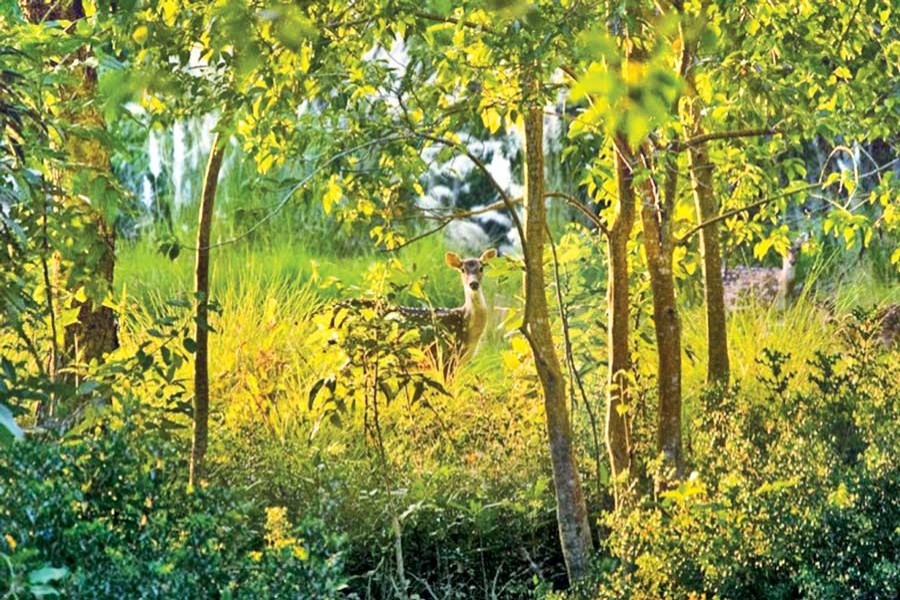
Climate change, coal plants and threats to Sundarbans
Syful Islam | Monday, 9 December 2019

 The Sundarbans has once again proved the immeasurable necessity of its existence for wellbeing of the people living in coastal areas of Bangladesh. Perhaps the same was felt in Indian states of West Bengal and Odisha in November 2019 when tropical cyclone Bulbul hit the coasts of Bay of Bengal.
The Sundarbans has once again proved the immeasurable necessity of its existence for wellbeing of the people living in coastal areas of Bangladesh. Perhaps the same was felt in Indian states of West Bengal and Odisha in November 2019 when tropical cyclone Bulbul hit the coasts of Bay of Bengal.
The size of one of the world's largest mangrove forest is 10,000 square kilometres of which 6,017 sq km falls in Bangladesh's Khulna Division and the rest in India's West Bengal across South 24 Parganas and North 24 Parganas districts.
The forest is home to 453 faunal wildlife which includes nearly 290 varieties of birds, 120 types of fishes, 42 mammals, and 35 reptiles. It was named as the Sundarbans for the presence of Sundari (beautiful or pretty) trees in large volumes. Gewa and Garan as well as various types of shrubs are abundant in the largest forest of the country.
Exposed to climate change, Bangladesh, as one of the most vulnerable countries, is now more frequently hit by natural disasters. The climate change effects are also causing sea-level rise, and saltwater intrusion to land and water, as well as posing threat to food security and livelihoods.
It has threatened the ecosystem of the Sundarbans. The sea-level rise is affecting plants, animals, wildlife and fisheries through inundating lands by saltwater. According to some studies, the forest lost nearly 1.1 per cent or 66 square kilometres of area between 1970s and 2000 due to erosion caused by increased water flow during the monsoon.
The distressed situation is now threatening the people who make their living based on Sundarbans and they include fishermen and honey collectors. The forest supports livelihoods to thousands of people in greater Khulna region.
Also many manmade hazards are now posing serious threat to the existence of the Sundarbans. Environmental activists at home and abroad are seriously concerned about the future of the forest especially due to massive industrial expansion near the world heritage site. The UNESCO has called for not allowing setting up of any industrial units near the forest.
Attention is yet to be paid to the calls made by scientists, environmentalists, activists, and social workers who expressed concern over the move to set up industrial units, coal power plants and establishments that may be harmful for the forest and its dependents. A huge construction works are going on there.
Of the three coal-fired power plants, the 1320-megawatt coal-fired power plant in Rampal, is expected to begin generating power by February 2021, located in nearly 14 kilometers of the Sundarbans. The first unit of another 1,320 megawatt coal-fired power plant, namely 'Payra Power Plant', located in Kalapara is scheduled to supply electricity to the national grid soon and its impact on the forest and the ecology is also under watch of the global environmental bodies. The World Heritage Centre and the IUCN are also monitoring the impact of the under-construction 350 MW coal-fired power plant in Taltoli Upazila under Barguna district, close to the Sundarbans.
The environmentalists and UNESCO officials apprehend that the large volume of coals to be carried for the power plants, spreading coal dust on river water, spewing tonnes of coal ash, discharging mercury-laden used water into the nearest rivers will destroy the ecology and biodiversity of the largest mangrove forest.
Media reported that in the recent years several incidents of oil spill and chemical shower to the rivers surrounding the Sundarbans took place as a good number of oil and coal-laden vessels sunk. These have serious negative effects on the ecology and biodiversity of the Sundarbans. Data show that some eight vessels sank in the rivers that flow through the Sundarbans between March 2013 and April 2018.
In April last year a vessel carrying 775 tonnes of coal sank in the Pasur river in Sundarbans. The biggest disastrous incident took place in Sundarbans in December 2014 when a large sized oil tanker carrying over 94,500 gallons of furnace oil sank in Shela river of the Sundarbans.
Following the incident oil spread over a 350-square-kilometre area and to a second river and scores of canals surrounding the forest blackening waters and shoreline. The heavy oil threatened trees and vast populations of small fish, Irrawaddy and Ganges dolphins.
On November 15, 2007 Category-5 equivalent tropical cyclone Sidr hit Bangladesh coast with a speed of over 200-kilometre per hour. The cyclone ravaged many parts of the coastal districts killing several thousand and destroying homes and various establishments. It was estimated that some 40 per cent area of the Sundarbans was damaged, thousands of birds, wild animals and other residents of the forest died as the cyclone hit.
Two years later in May 2009 severe cyclonic storm Aila hit south-western Bangladesh killing hundreds and causing worst damage. The storm also damaged many parts of the Sundarbans forest, spoiled farmland, and killed thousands of wild animals living inside the forest area.
Now the role of Sundarbans is yet again seriously discussed by many with the latest cyclone Bulbul hitting the Bangladesh's coast. The storm wiped out trees and structures inside the forest and also some residents died. Media reports show that some 26 people were killed in nine coastal districts during the two days when cyclone Bulbul ravaged the southern part of the country. The damage from this cyclone was not as before or as feared since the forest embraced the cyclone before it could hit the coastal areas with full strength.
Experts and environmentalists said the storms could not hit with its full force in the costs since the forest stood as a big wall in front of them. The cyclones weakened after facing the forests before reaching the mainland; thus the damages were comparatively low. As Bulbul lost its strength to the Sundarbans forest, lives of hundreds of possible victims were saved and the area had been able to avoid damages worth billions of taka.
We need to keep the forest intact for our own sake -for wellbeing of people, and of course for wellbeing of the country. In the era of climate change, when other counties are taking adaptation and mitigation measures that include massive forestation, we should not destroy our God-gifted natural forest. It does not take a long time for man-made hazards to destroy a forest like the Sundarbans that cannot be raised even with the best of human efforts. We should take care of the forest and the government should employ all possible efforts to save it from the manmade hazards.
Syful Islam is a Senior Reporter at The Financial Express.
[email protected]